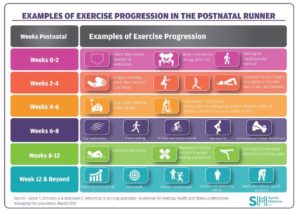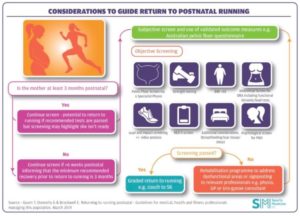Womens’s health, “Returning to running postnatal” guidelines


I am delighted to be implementing the new “Returning to running postnatal” guidelines published this March by Gráinne Donnelly, Emma Brockwell and Tom Goom, as part of our post partum care at The Physio clinic Balbriggan.
We want to encourage postpartum women to return to running safely and successfully without potential risk of injury. Looking at both the prevention and management of postpartum issues, and these new guidelines really pave the way to doing this.
Common postnatal pelvic health issues such as urinary incontinence are understood to create a barrier to exercise (Nygaard et al. 2005). However engagement in regular physical activity is essential for new mum’s, for both the mental and physical benefits.
After having a baby, the pelvic floor is weak and injured in most women and they may need instruction and supervision to be able to perform a correct pelvic floor muscle contraction, especially in those women who did not train these muscles before birth (Bø et al. 2017).
High-impact activity, such as running, is associated with a sudden rise in intra-abdominal pressure (Leitner et al. 2016). It has also been reported that ground reaction forces of between 1.6 and 2.5 times bodyweight can occur when running at a moderate speed of 11 Kilometers/hour (Gottschall and Kram 2005).
Presently, it is unknown if or how much of this is absorbed through the lower limb on impact and therefore it is assumed that some, if not all, of those forces are also transmitted to the pelvic floor. This highlights the importance of strength and speed of contraction in the pelvic floor muscles in order to carry out their role in pelvic organ support and continence during high impact activities (Leitner et al. 2016).
It also helps reason why weak, less co-ordinated muscles in postnatal women may not achieve the level of function needed to maintain these roles and highlights the importance and indication for adequate rehabilitation.
These guideline state:
“Evidence-Based Recommendation 1: Postnatal women can benefit from individualized assessment and guided pelvic floor rehabilitation for the prevention and management of pelvic organ prolapse, the management of urinary incontinence and for improved sexual function.”
Postnatal women need adequate time to heal and regain strength, particularly in the abdominal and pelvic floor muscles after pregnancy and delivery.
“Evidence-Based Recommendation 2: Return to running is not advisable prior to 3 months postnatal or beyond this if any symptoms of pelvic floor dysfunction are identified prior to, or after attempting, return to running.”
Post natal treatment starts with a detailed assessment which leads to an individualized treatment plan. You can read more about Women’s health physiotherapy and what a post natal assessment may involve in our “Women’s health” section.
The full return to running post natal guidelines can be found here: https://www.running-physio.com/postnatal-guide/
Zara Bowler
Chartered Physiotherapist , MISCP CORU
